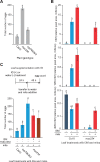Multiple indole glucosinolates and myrosinases defend Arabidopsis against Tetranychus urticae herbivory
- PMID: 34618148
- PMCID: PMC8418412
- DOI: 10.1093/plphys/kiab247
Multiple indole glucosinolates and myrosinases defend Arabidopsis against Tetranychus urticae herbivory
Abstract
Arabidopsis (Arabidopsis thaliana) defenses against herbivores are regulated by the jasmonate (JA) hormonal signaling pathway, which leads to the production of a plethora of defense compounds. Arabidopsis defense compounds include tryptophan-derived metabolites, which limit Arabidopsis infestation by the generalist herbivore two-spotted spider mite, Tetranychus urticae. However, the phytochemicals responsible for Arabidopsis protection against T. urticae are unknown. Here, we used Arabidopsis mutants disrupted in the synthesis of tryptophan-derived secondary metabolites to identify phytochemicals involved in the defense against T. urticae. We show that of the three tryptophan-dependent pathways found in Arabidopsis, the indole glucosinolate (IG) pathway is necessary and sufficient to assure tryptophan-mediated defense against T. urticae. We demonstrate that all three IGs can limit T. urticae herbivory, but that they must be processed by myrosinases to hinder T. urticae oviposition. Putative IG breakdown products were detected in mite-infested leaves, suggesting in planta processing by myrosinases. Finally, we demonstrate that besides IGs, there are additional JA-regulated defenses that control T. urticae herbivory. Together, our results reveal the complexity of Arabidopsis defenses against T. urticae that rely on multiple IGs, specific myrosinases, and additional JA-dependent defenses.
© American Society of Plant Biologists 2021. All rights reserved. For permissions, please email: journals.permissions@oup.com.
Figures








References
-
- Barth C, Jander G (2006) Arabidopsis myrosinases TGG1 and TGG2 have redundant function in glucosinolate breakdown and insect defense. Plant J 46: 549–562 - PubMed
-
- Bednarek P, Pislewska-Bednarek M, Svatos A, Schneider B, Doubsky J, Mansurova M, Humphry M, Consonni C, Panstruga R, Sanchez-Vallet A, et al. (2009) A glucosinolate metabolism pathway in living plant cells mediates broad-spectrum antifungal defense. Science 323: 101–106 - PubMed
Publication types
MeSH terms
Substances
LinkOut - more resources
Full Text Sources
Molecular Biology Databases

